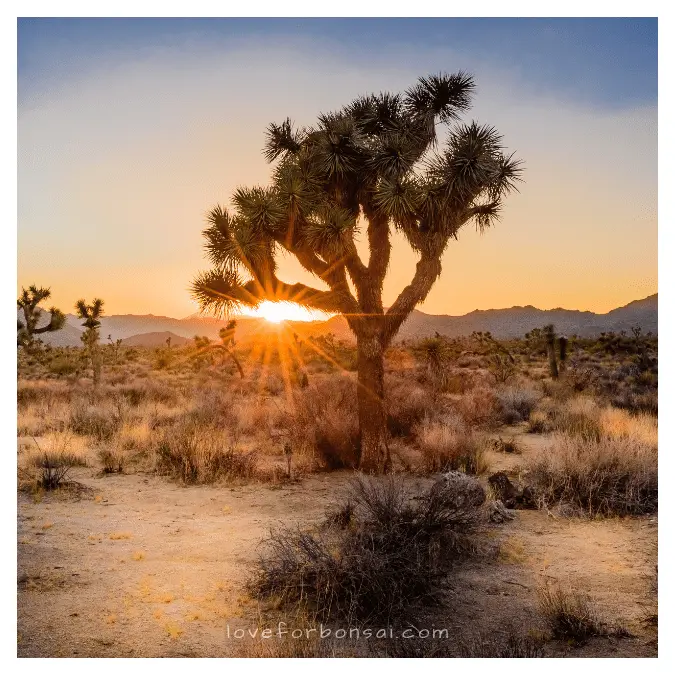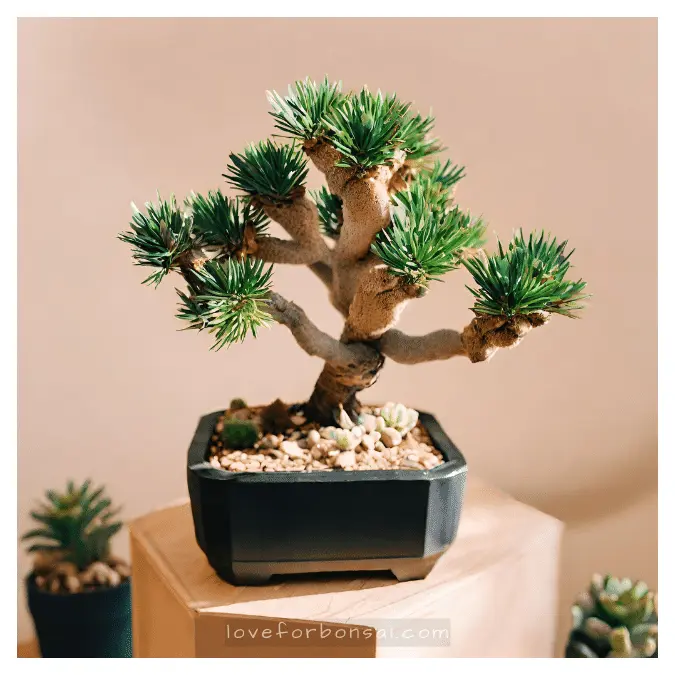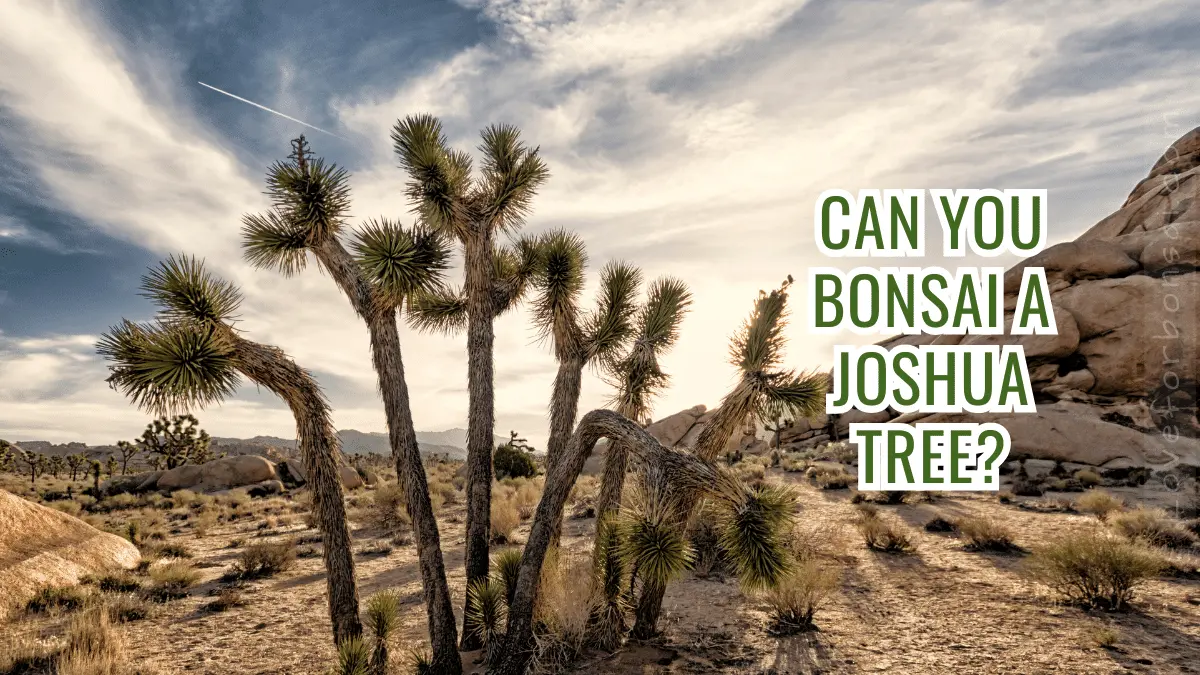In the world of bonsai gardening, the possibilities are endless. For over 15 years, I’ve had the pleasure of working with various types of bonsai, each offering its unique challenges and rewards.
But one question that often comes up is whether it’s possible to bonsai a Joshua Tree, that iconic symbol of the American Southwest.
In this blog post, we’ll explore the fascinating world of Joshua Tree bonsai, breaking down the process step by step. Follow along to see if this unusual desert plant can be styled into an artful bonsai.
What Is a Joshua Tree?

Before we dive into bonsai techniques, let’s get to know the star of our show—the Joshua Tree. Joshua Trees (Yucca brevifolia) are native to the southwestern United States, particularly in the Mojave Desert. These striking trees are known for their tall, spiky leaves and distinctive, almost otherworldly appearance.
- Scientific Name: Yucca brevifolia
- Family: Asparagaceae
- Native Region: Southwestern United States
- Characteristics: Tall, spiky leaves, slow growth, iconic appearance
The Art of Bonsai
Bonsai, which originated in East Asia and found its way to Japan, is the art of growing and training miniature trees in containers. The word “bonsai” itself means “tray-planted” in Japanese. Bonsai involves carefully shaping and nurturing a tree to create a miniature representation of its full-sized counterpart.
Ficus Religiosa Bonsai Tree Care Guide
Can Joshua Trees Be Bonsai Trees?
Bonsai-ing a Joshua tree is possible, but it may come with some challenges due to the unique characteristics of the tree.
Joshua trees (Yucca brevifolia) are not traditional trees; they are actually succulent plants and belong to the Yucca genus. Bonsai is typically associated with woody trees and shrubs, and creating a bonsai from a succulent like the Joshua tree can be quite different.
Here are some considerations if you want to bonsai a Joshua tree:
- Growth Rate: Joshua trees are slow growers, and they have a unique growth pattern. They typically start as a rosette of leaves near the ground and grow upward over time. This growth pattern can be challenging to manipulate into a traditional bonsai style.
- Pruning and Styling: Unlike traditional bonsai trees with branches and leaves, Joshua trees have long, slender leaves and spiky branches. Pruning and shaping them may not be as straightforward as with other species. You might need to be patient and creative in your styling approach.
- Soil and Pot: Choose a well-draining soil mix suitable for succulents, as Joshua trees prefer sandy, well-draining soil. The pot should also have good drainage to prevent waterlogging.
- Climate: Consider your local climate when growing a Joshua tree bonsai. Joshua trees are native to arid regions of the southwestern United States, so they are adapted to hot and dry conditions. Make sure they get adequate sunlight and protection from freezing temperatures if you live in a colder area.
- Repotting: Repotting a Joshua tree bonsai should be done sparingly, as they do not like root disturbance. It’s best to repot them infrequently and with care.
- Watering: Water sparingly, allowing the soil to dry out between watering sessions. Overwatering can lead to root rot, which is a common issue with succulents.
- Patience: Growing a bonsai, especially from a slow-growing species like the Joshua tree, requires patience. It may take many years to achieve the desired bonsai form.
So as you can see, while it’s possible to create a bonsai from a Joshua tree, it may not fit the traditional bonsai mold due to its unique growth habits.
If you’re up for the challenge and willing to experiment, you can give it a try. However, keep in mind that Joshua trees are also protected in some areas, so make sure you’re not violating any regulations if you collect one from the wild.
How to Create A Bonsai From Joshua Trees:
Bonsai-ing a Joshua tree can be a unique and challenging project due to the characteristics of Joshua trees, which are actually succulent plants. Here are some general steps and considerations for bonsai-ing a Joshua tree:

- Selecting a Young Joshua Tree: Start with a young Joshua tree or a seedling, as they are more adaptable to bonsai cultivation. Older trees may have a more established growth pattern that is harder to manipulate.
- Choosing the Right Container: Select a suitable bonsai pot with good drainage. The pot should be large enough to accommodate the roots but small enough to maintain the miniature size characteristic of bonsai.
- Well-Draining Bonsai Soil: Use a well-draining bonsai soil mix suitable for succulents. Joshua trees thrive in sandy, well-draining soil.
- Pruning: Prune the Joshua tree carefully to shape it into a bonsai form. Bear in mind that Joshua trees have long, slender leaves and spiky branches, which may not conform to traditional bonsai styles. You may need to be creative in shaping and styling.
- Wiring: Wiring can be used to gently bend and shape branches to achieve the desired form. Be cautious when wiring, as the branches can be brittle.
- Repotting: Repotting should be done sparingly, as Joshua trees do not like root disturbance. Repotting is typically done every few years when the tree has outgrown its current container. Be sure to trim the roots during repotting to maintain the desired size.
- Watering: Water sparingly, allowing the soil to dry out between waterings. Overwatering can lead to root rot, so it’s crucial to let the soil dry partially before watering again.
- Sunlight: Place your Joshua tree bonsai in a location with plenty of sunlight. Joshua trees are native to arid regions and require full sun for healthy growth.
- Protection from Cold: If you live in an area with cold winters, protect your Joshua tree bonsai from freezing temperatures. They are not cold-hardy and can be damaged by frost.
- Patience: Growing a Joshua tree bonsai can be a slow process. Be patient and allow the tree to develop over time. It may take several years to achieve a mature bonsai look.
- Fertilizing: Use a balanced, diluted bonsai fertilizer during the growing season to provide essential nutrients for healthy growth.
- Pest and Disease Management: Keep an eye out for pests and diseases that can affect Joshua trees and treat any issues promptly.
Challenges and Rewards
Bonsai-ing a Joshua Tree can be challenging, but the rewards are equally significant. Watching your miniature Joshua Tree evolve and thrive is a gratifying experience. It’s a testament to the resilience of nature and the artistry of bonsai.
Can I Grow Black Walnut As a Bonsai: 10 Tips To Remember
Conclusion
While challenging, bonsaiing a Joshua tree can be done with proper care and patience. Let me know if you try bonsaiing a Joshua tree or other desert plant.
And be sure to explore the other articles on the site for more bonsai inspiration. With the right guidance and determination, you may be surprised what kinds of plants can be sculpted into a living art form.
